1996 TOYOTA 4RUNNER towing
[x] Cancel search: towingPage 27 of 217
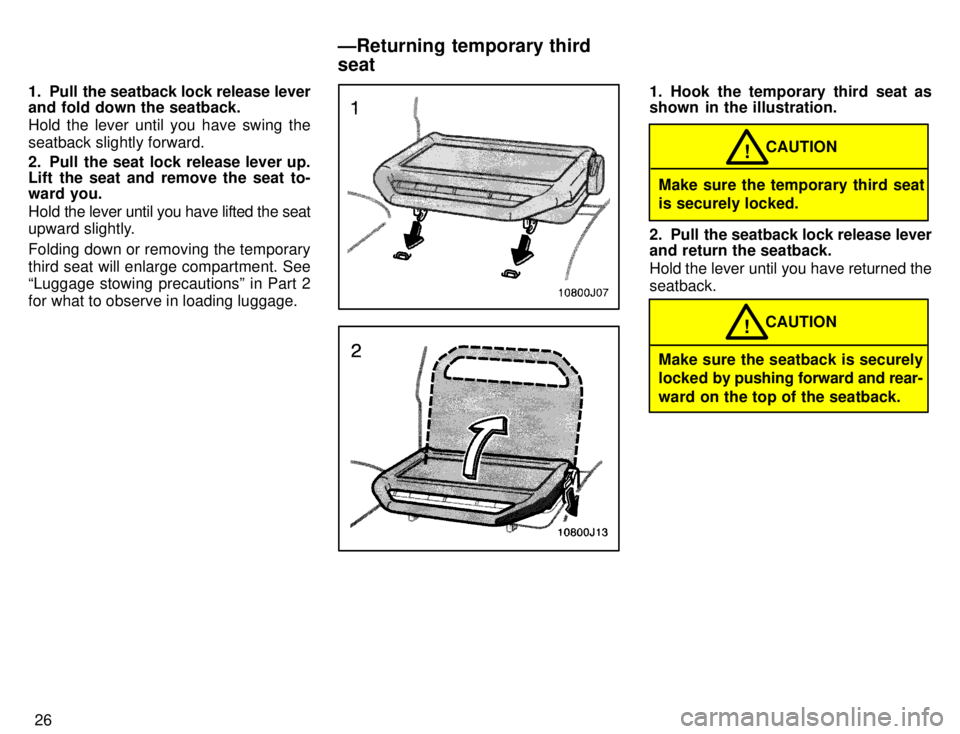
26
1. Pull the seatback lock release lever
and fold down the seatback.
Hold the lever until you have swing the
seatback slightly forward.
2. Pull the seat lock release lever up.
Lift the seat and remove the seat to-
ward you.
Hold
the lever until you have lifted the seat
upward slightly. Folding down or removing the temporary third seat will enlarge compartment. See
Luggage stowing precautionsº in Part 2
for what to observe in loading luggage.
1. Hook the temporary third seat as
shown in the illustration.
CAUTION!
Make sure the temporary third seat
is securely locked.
2. Pull the seatback lock release lever
and return the seatback.
Hold the lever until you have returned the seatback.
CAUTION!
Make sure the seatback is securely
locked by pushing forward and rear-
ward on the top of the seatback.
ÐReturning temporary third seat
Page 34 of 217
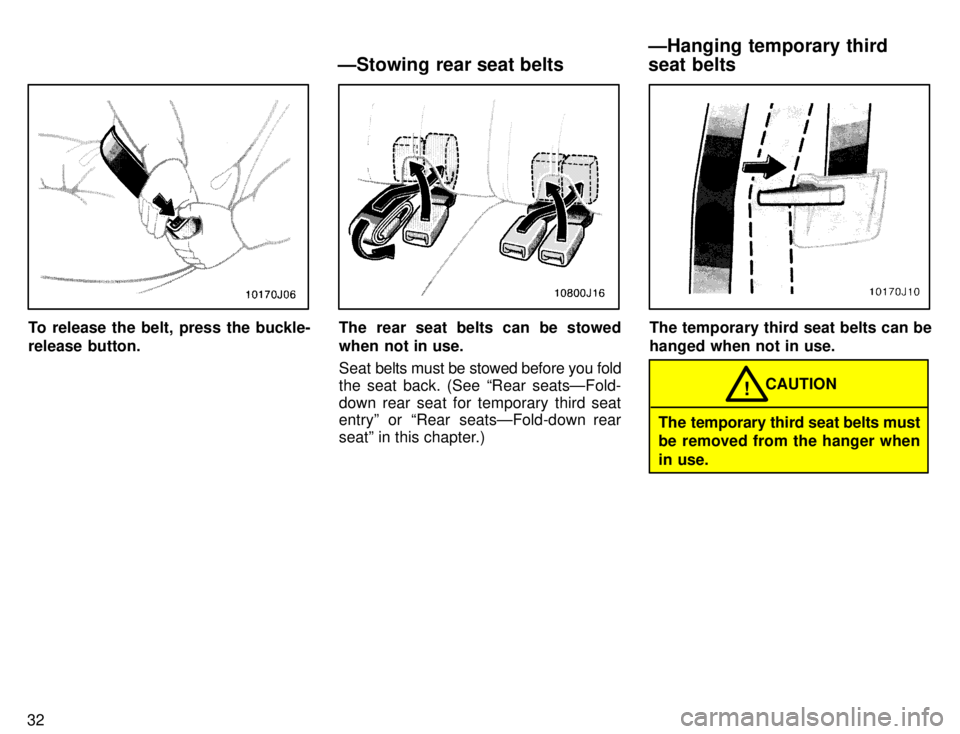
32
To release the belt, press the buckle-
release button.The rear seat belts can be stowed
when not in use.
Seat belts must be stowed before you fold
the seat back. (See Rear seatsÐFold-
down rear seat for temporary third seat
entryº or Rear seatsÐFold-down rear
seatº in this chapter.)The temporary third seat belts can be hanged when not in use.
CAUTION!
The temporary third seat belts must
be removed from the hanger when
in use.
ÐStowing rear seat belts
ÐHanging temporary thirdseat belts
Page 63 of 217
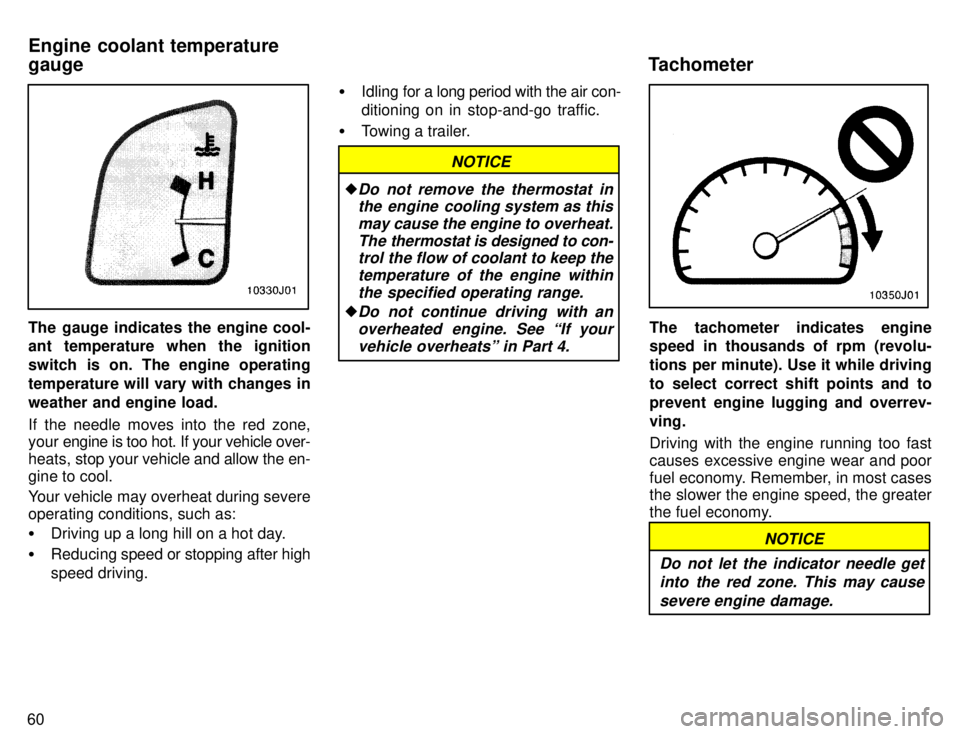
60
The gauge indicates the engine cool-
ant temperature when the ignition
switch is on. The engine operating
temperature will vary with changes inweather and engine load.
If the needle moves into the red zone, your engine is too hot. If your vehicle over-
heats, stop your vehicle and allow the en-
gine to cool.
Your vehicle may overheat during severe operating conditions, such as: � Driving up a long hill on a hot day.
� Reducing speed or stopping after high
speed driving. �
Idling for a long period with the air con-
ditioning on in stop-and-go traffic.
� Towing a trailer.
NOTICE
�Do not remove the thermostat in
the engine cooling system as this
may cause the engine to overheat.
The thermostat is designed to con-trol the flow of coolant to keep the
temperature of the engine within the specified operating range.
�Do not continue driving with anoverheated engine. See If yourvehicle overheatsº in Part 4.
The tachometer indicates engine
speed in thousands of rpm (revolu-
tions per minute). Use it while driving
to select correct shift points and to
prevent engine lugging and overrev-ving.
Driving with the engine running too fast
causes excessive engine wear and poor
fuel economy. Remember, in most cases
the slower the engine speed, the greater
the fuel economy.
NOTICE
Do not let the indicator needle get into the red zone. This may cause
severe engine damage.
Tachometer
Engine coolant temperature gauge
Page 70 of 217
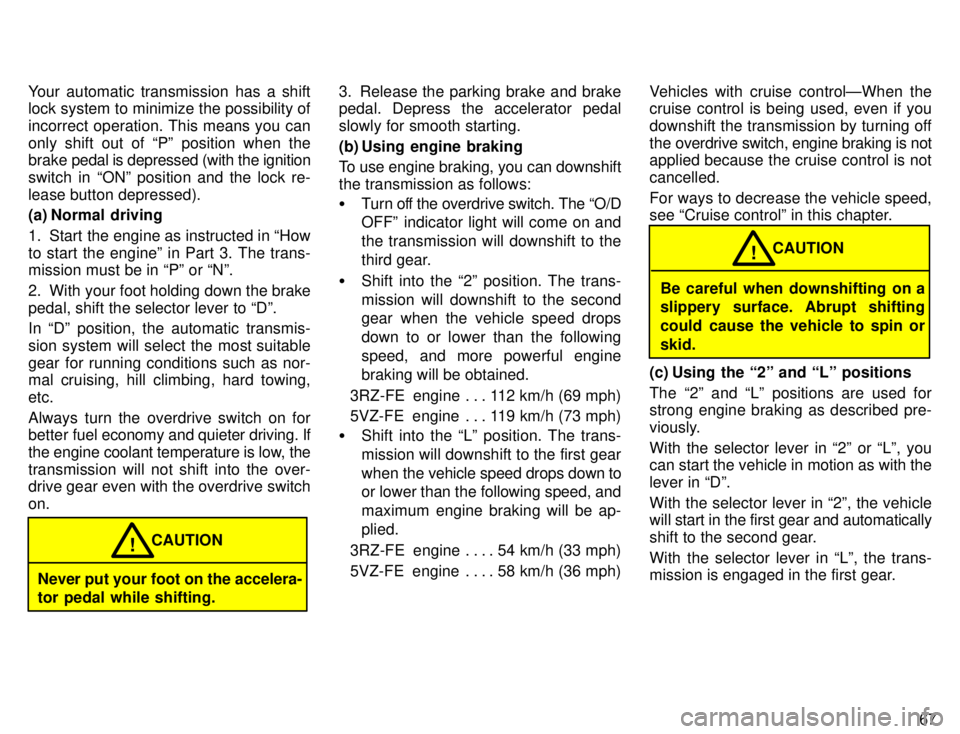
67
Your automatic transmission has a shift
lock system to minimize the possibility of
incorrect operation. This means you can
only shift out of Pº position when the brake
pedal is depressed (with the ignition
switch in ONº position and the lock re-
lease button depressed).
(a) Normal driving
1. Start the engine as instructed in How
to start the engineº in Part 3. The trans- mission must be in Pº or Nº.
2. With your foot holding down the brake
pedal, shift the selector lever to Dº.
In Dº position, the automatic transmis-
sion system will select the most suitable
gear for running conditions such as nor-
mal cruising, hill climbing, hard towing, etc.
Always turn the overdrive switch on for
better fuel economy and quieter driving. If
the engine coolant temperature is low, the transmission will not shift into the over-
drive gear even with the overdrive switch on.
Never put your foot on the accelera-
tor pedal while shifting. CAUTION
! 3. Release the parking brake and brake
pedal. Depress the accelerator pedal
slowly for smooth starting.
(b) Using engine braking
To use engine braking, you can downshift the transmission as follows: �
Turn off the overdrive switch. The O/D
OFFº indicator light will come on and the transmission will downshift to the
third gear.
� Shift into the 2º position. The trans-
mission will downshift to the second
gear when the vehicle speed drops down to or lower than the followingspeed, and more powerful engine
braking will be obtained.
3RZ-FE engine 112 km/h (69 mph) . . .
5VZ-FE engine 119 km/h (73 mph) . . .
� Shift into the Lº position. The trans-mission will downshift to the first gear
when the vehicle speed drops down to
or lower than the following speed, and
maximum engine braking will be ap-plied.
3RZ-FE engine 54 km/h (33 mph) . . . .
5VZ-FE engine 58 km/h (36 mph) . . . . Vehicles with cruise controlÐWhen the
cruise control is being used, even if you
downshift the transmission by turning off
the overdrive switch, engine braking is not
applied because the cruise control is not cancelled.
For ways to decrease the vehicle speed,
see Cruise controlº in this chapter.
Be careful when downshifting on a
slippery surface. Abrupt shifting
could cause the vehicle to spin orskid.
CAUTION
!
(c) Using the 2º and Lº positions
The 2º and Lº positions are used for
strong engine braking as described pre-
viously. With the selector lever in 2º or Lº, you
can start the vehicle in motion as with the
lever in Dº. With the selector lever in 2º, the vehicle
will start in the first gear and automatically
shift to the second gear.
With the selector lever in Lº, the trans-
mission is engaged in the first gear.
Page 71 of 217
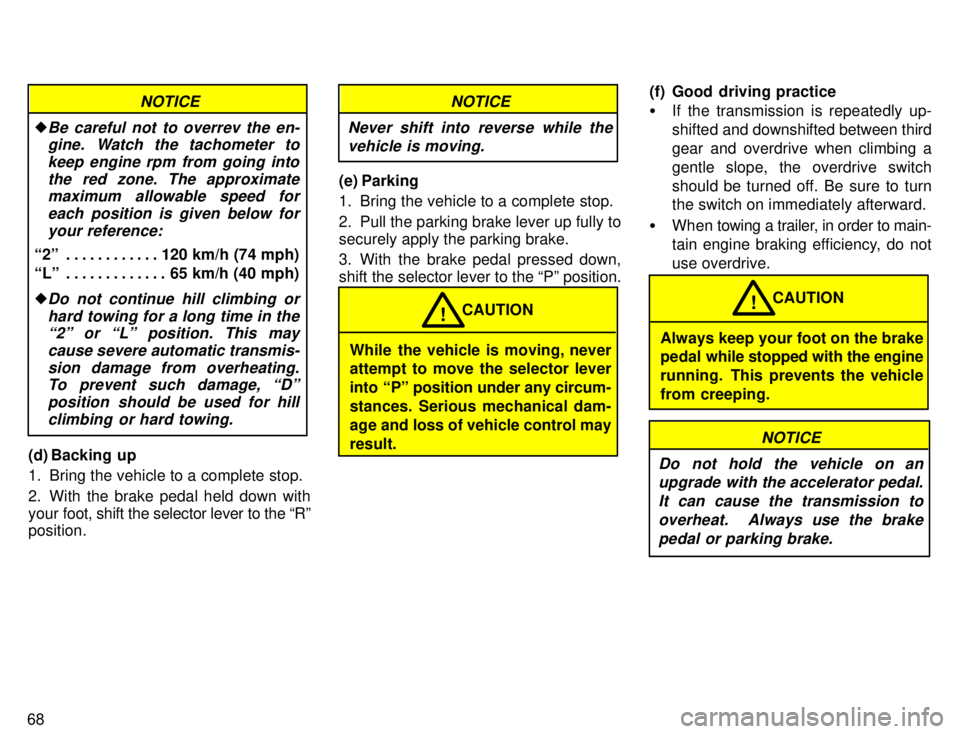
68
NOTICE
�Be careful not to overrev the en-gine. Watch the tachometer to
keep engine rpm from going into the red zone. The approximatemaximum allowable speed for
each position is given below for
your reference:
2º 120 km/h (74 mph) . . . . . . . . . . . .
Lº 65 km/h (40 mph) . . . . . . . . . . . . .
�
Do not continue hill climbing or hard towing for a long time in the2º or Lº position. This may
cause severe automatic transmis-sion damage from overheating.To prevent such damage, Dº
position should be used for hill climbing or hard towing.
(d) Backing up
1. Bring the vehicle to a complete stop.
2. With the brake pedal held down with your foot, shift the selector lever to the Rº
position.
NOTICE
Never shift into reverse while the vehicle is moving.
(e) Parking
1. Bring the vehicle to a complete stop.
2. Pull the parking brake lever up fully to securely apply the parking brake.
3. With the brake pedal pressed down,
shift the selector lever to the Pº position.
While the vehicle is moving, never
attempt to move the selector lever
into Pº position under any circum-
stances. Serious mechanical dam-
age and loss of vehicle control mayresult. CAUTION
! (f) Good driving practice �
If the transmission is repeatedly up-
shifted and downshifted between third
gear and overdrive when climbing a
gentle slope, the overdrive switch
should be turned off. Be sure to turn the switch on immediately afterward.
� When towing a trailer, in order to main-
tain engine braking efficiency, do notuse overdrive.
Always keep your foot on the brake
pedal w hile stopped with the engine
running. This prevents the vehicle
from creeping. CAUTION
!
NOTICE
Do not hold the vehicle on an upgrade with the accelerator pedal.
It can cause the transmission tooverheat. Always use the brake pedal or parking brake.
Page 74 of 217
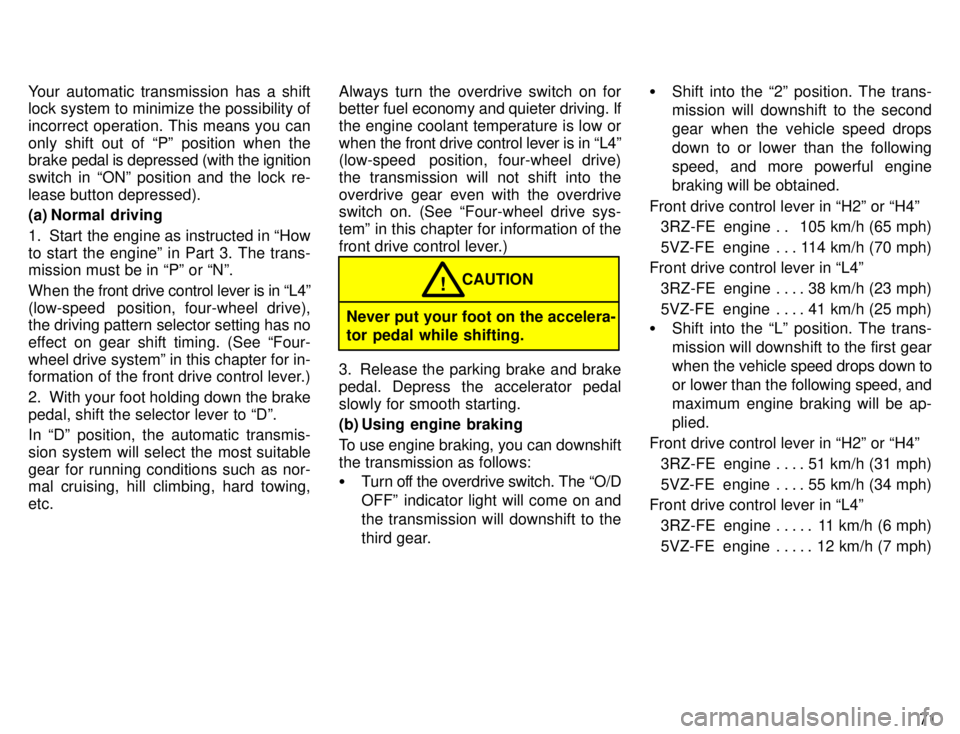
71
Your automatic transmission has a shift
lock system to minimize the possibility of
incorrect operation. This means you can
only shift out of Pº position when the brake
pedal is depressed (with the ignition
switch in ONº position and the lock re-
lease button depressed).
(a) Normal driving
1. Start the engine as instructed in How
to start the engineº in Part 3. The trans- mission must be in Pº or Nº.
When the front drive control lever is in L4º
(low-speed position, four-wheel drive),
the driving pattern selector setting has no
effect on gear shift timing. (See Four-
wheel drive systemº in this chapter for in-
formation of the front drive control lever.)
2. With your foot holding down the brake
pedal, shift the selector lever to Dº.
In Dº position, the automatic transmis-
sion system will select the most suitable
gear for running conditions such as nor-
mal cruising, hill climbing, hard towing, etc. Always turn the overdrive switch on for
better
fuel economy and quieter driving. If
the engine coolant temperature is low or
when the front drive control lever is in L4º
(low-speed position, four-wheel drive)
the transmission will not shift into the
overdrive gear even with the overdrive
switch on. (See Four-wheel drive sys-
temº in this chapter for information of the
front drive control lever.)
Never put your foot on the accelera- tor pedal while shifting. CAUTION
!
3. Release the parking brake and brake
pedal. Depress the accelerator pedal
slowly for smooth starting.
(b) Using engine braking
To use engine braking, you can downshift the transmission as follows: � Turn off the overdrive switch. The O/D
OFFº indicator light will come on andthe transmission will downshift to the
third gear. �
Shift into the 2º position. The trans-
mission will downshift to the second
gear when the vehicle speed dropsdown to or lower than the followingspeed, and more powerful engine
braking will be obtained.
Front drive control lever in H2º or H4º 3RZ-FE engine 105 km/h (65 mph) . .
5VZ-FE engine 114 km/h (70 mph) . . .
Front drive control lever in L4º
3RZ-FE engine 38 km/h (23 mph) . . . .
5VZ-FE engine 41 km/h (25 mph) . . . .
� Shift into the Lº position. The trans-mission will downshift to the first gear
when the vehicle speed drops down to
or lower than the following speed, and
maximum engine braking will be ap-plied.
Front drive control lever in H2º or H4º 3RZ-FE engine 51 km/h (31 mph) . . . .
5VZ-FE engine 55 km/h (34 mph) . . . .
Front drive control lever in L4º
3RZ-FE engine 11 km/h (6 mph) . . . . .
5VZ-FE engine 12 km/h (7 mph) . . . . .
Page 75 of 217
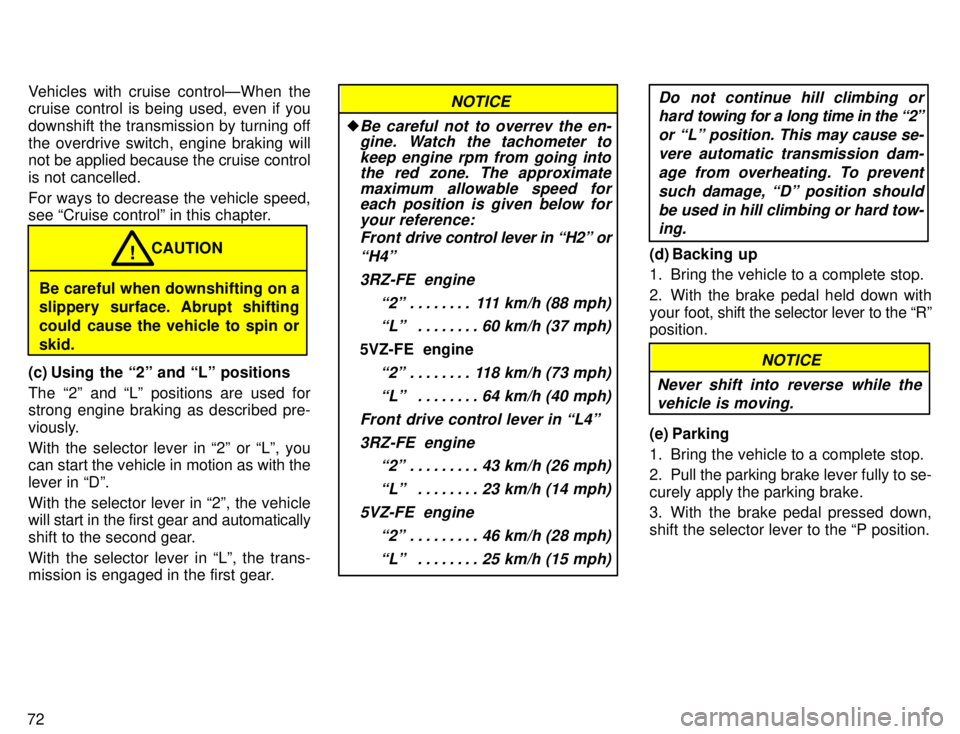
72Vehicles with cruise controlÐWhen the
cruise control is being used, even if you
downshift the transmission by turning offthe overdrive switch, engine braking will
not be applied because the cruise control is not cancelled. For ways to decrease the vehicle speed,
see Cruise controlº in this chapter.
Be careful when downshifting on a
slippery surface. Abrupt shifting
could cause the vehicle to spin orskid.
CAUTION
!
(c) Using the 2º and Lº positions The 2º and Lº positions are used for
strong engine braking as described pre-
viously. With the selector lever in 2º or Lº, you
can start the vehicle in motion as with the
lever in Dº. With the selector lever in 2º, the vehicle
will start in the first gear and automatically
shift to the second gear.
With the selector lever in Lº, the trans-
mission is engaged in the first gear.
NOTICE
�Be careful not to overrev the en- gine. Watch the tachometer to
keep engine rpm from going intothe red zone. The approximate
maximum allowable speed foreach position is given below for
your reference:
Front drive control lever in H2º or
H4º
3RZ-FE engine 2º 111 km/h (88 mph) . . . . . . . .
Lº 60 km/h (37 mph) . . . . . . . .
5VZ-FE engine
2º 118 km/h (73 mph). . . . . . . .
Lº 64 km/h (40 mph) . . . . . . . .
Front drive control lever in L4º 3RZ-FE engine 2º 43 km/h (26 mph) . . . . . . . . .
Lº 23 km/h (14 mph) . . . . . . . .
5VZ-FE engine 2º 46 km/h (28 mph) . . . . . . . . .
Lº 25 km/h (15 mph) . . . . . . . .
Do not continue hill climbing or
hard towing for a long time in the 2º
or Lº position. This may cause se- vere automatic transmission dam-age from overheating. To preventsuch damage, Dº position should be used in hill climbing or hard tow-ing.
(d) Backing up
1. Bring the vehicle to a complete stop.
2. With the brake pedal held down with your foot, shift the selector lever to the Rº
position.
NOTICE
Never shift into reverse while the vehicle is moving.
(e) Parking
1. Bring the vehicle to a complete stop.
2. Pull the parking brake lever fully to se- curely apply the parking brake.
3. With the brake pedal pressed down,
shift the selector lever to the P position.
Page 76 of 217
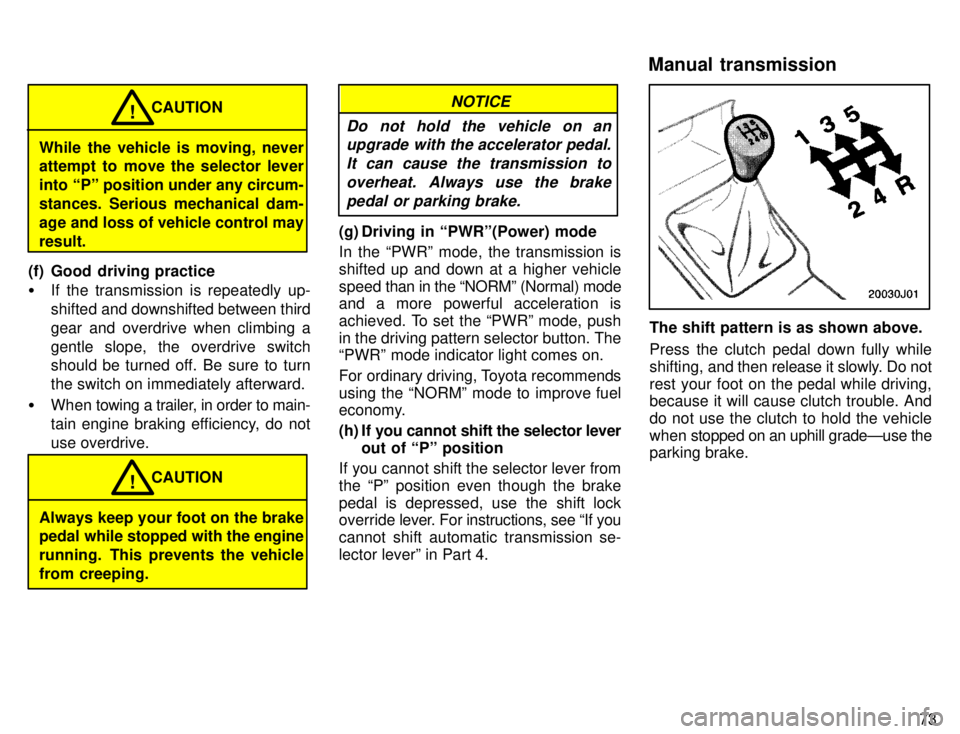
73
While the vehicle is moving, never
attempt to move the selector lever
into Pº position under any circum-
stances. Serious mechanical dam-
age and loss of vehicle control mayresult.CAUTION
!
(f) Good driving practice � If the transmission is repeatedly up-
shifted and downshifted between third
gear and overdrive when climbing a
gentle slope, the overdrive switch
should be turned off. Be sure to turn the switch on immediately afterward.
� When towing a trailer, in order to main-
tain engine braking efficiency, do notuse overdrive.
Always keep your foot on the brake
pedal while stopped with the engine
running. This prevents the vehicle
from creeping. CAUTION
!
NOTICE
Do not hold the vehicle on an upgrade with the accelerator pedal.
It can cause the transmission tooverheat. Always use the brake pedal or parking brake.
(g) Driving in PWRº(Power) mode
In the PWRº mode, the transmission is shifted up and down at a higher vehicle
speed than in the NORMº (Normal) mode
and a more powerful acceleration is
achieved. To set the PWRº mode, push
in the driving pattern selector button. The
PWRº mode indicator light comes on.
For ordinary driving, Toyota recommends
using the NORMº mode to improve fuel
economy.
(h) If you cannot shift the selector lever
out of Pº position
If you cannot shift the selector lever from the Pº position even though the brake
pedal is depressed, use the shift lock
override lever. For instructions, see If you
cannot shift automatic transmission se- lector leverº in Part 4.
The shift pattern is as shown above.
Press the clutch pedal down fully while
shifting, and then release it slowly. Do not
rest your foot on the pedal while driving, because it will cause clutch trouble. And do not use the clutch to hold the vehicle
when stopped on an uphill gradeÐuse the
parking brake.
Manual transmission